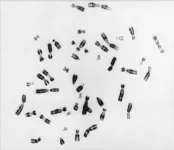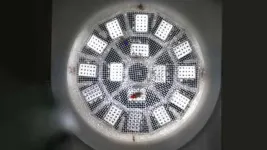(Press-News.org) Having extra chromosomes is typically an issue for an organism and can disrupt development or cause disease. But some cells benefit instead: For example, cancer cells or pathogenic yeasts can use extra chromosomes to escape treatment and become drug-resistant. A team of researchers from Charité – Universitätsmedizin Berlin has now deciphered how yeasts manage to compensate for the genetic imbalance. Their findings, published in the journal Nature,* could yield new approaches to dealing with treatment-resistant tumors or fungal infections.
The typical healthy human cell has exactly two copies of 23 chromosomes, where all of the person’s genetic information is stored. If an error occurs during cell division, resulting in three or more copies of a chromosome, that is too much of a good thing: The genes present on the duplicate chromosome are “read” more frequently overall, so their products – proteins – build up to abnormal levels. This can disrupt an organism’s development, as in the case of trisomies like Down syndrome, or make an organism nonviable in the first place. This makes aneuploidy, the medical term for an abnormal number of chromosomes, a frequent cause of miscarriage.
Surprisingly, however, there are also cells and organisms that have learned to cope with the excess of genes and even benefit from it. Some cancer cells, for example, can harness additional chromosomes to better defend against tumor medications and continue to grow despite treatment. Aneuploidy is also very common in yeasts, a type of single-celled fungus: An estimated one-fifth of all natural strains of the bakery or wine yeast Saccharomyces cerevisiae have an abnormal set of chromosomes.
All proteins exchanged faster
Researchers have been studying how these cells manage to deal with the extra chromosomes for years. A research group headed by Prof. Markus Ralser, Director of the Institute of Biochemistry at Charité, has now traced a previously unknown compensation mechanism based on one species of yeast. “We were able to show that naturally occurring aneuploid yeast cells buffer the harmful protein burden by exchanging all proteins faster,” Ralser explains.
For their study, the researchers compared “genetically healthy” yeast strains against strains in which aneuploidy was induced in a lab and others that had been isolated from a wide variety of environmental niches around the world and had abnormal numbers of chromosomes by nature. Unlike the lab-grown strains, the natural ones had had longer to become accustomed to the excess of chromosomes. For each of the approximately 800 strains studied, the researchers determined the activity of the genes and the quantity of all proteins. To do this, they utilized mass spectrometry, a method that can be used to measure hundreds of proteins from a single sample. Analysis of these vast quantities of data showed that most of the strains that had been aneuploid for a long time had compensated for the proteins encoded by the extra chromosome, meaning that these proteins were present at levels more similar to healthy yeasts.
Then the team studied how the yeasts achieved this. “Our data show that a system called the proteasome system is ramped up, meaning that the cellular recycling machinery is more active,” explains Dr. Julia Münzner, the study’s first author, who works at the Institute of Biochemistry at Charité. “So, cells with extra chromosomes run at full blast, producing a lot, but they are also faster at breaking those products back down.” That reduces the volume of extra proteins, although the turnover of other proteins is also faster. The researchers suspect that the cells have another way to stabilize the non-excess proteins so they are not overly decimated.
An approach to tackle drug resistance?
The researchers hope the new findings can be used as an approach to fighting treatment-resistant tumors and fungal infections. Like cancer cells, pathogenic yeasts like Candida albicans can also become resistant to drugs if they have additional chromosomes. Fungal infections that are no longer treatable can be fatal.
“For example, it would be conceivable to use medications to slow the breakdown of proteins in the cells so they would go back to having to deal with an elevated protein burden,” Ralser says. “That could be a way to prevent treatment resistance.” For this approach to work, cancer cells and pathogenic yeasts would have to apply a principle similar to that found in Saccharomyces cerevisiae to tolerate aneuploidy. Finding that out is the research group’s next objective.
About the study
The study was led by Prof. Markus Ralser and Prof. Judith Berman. Ralser holds the title of Einstein Professor of Biochemistry. In addition to the Institute of Biochemistry at Charité, he also heads a research group at the Nuffield Department of Medicine at the University of Oxford. Berman is the head of a lab at the Shmunis School of Biomedical and Cancer Research at Tel Aviv University. The researchers’ work was supported by a Synergy Grant from the European Research Council (ERC), which Ralser and Berman jointly hold.
*Muenzner J. et al. Natural proteome diversity links aneuploidy tolerance to protein turnover. Nature 2024 May 22. doi: 10.1038/s41586-024-07442-9
END
Charité study in Nature: How cells deal with extra chromosomes
2024-05-22
ELSE PRESS RELEASES FROM THIS DATE:
SwRI highlights NEXTCAR II project innovations at 2024 ARPA-E Innovation Summit
2024-05-22
SAN ANTONIO — May 22, 2024 — Southwest Research Institute will share the latest developments from its ongoing NEXTCAR Phase II project at the 2024 ARPA-E Energy Innovation Summit in Dallas (May 22-24). The Institute’s NEXTCAR Program aims to reduce vehicular energy consumption by more than 30% using next generation connected and automated vehicle (CAV) technology.
“We are demonstrating real-world next-generation automated driving technology that puts SwRI’s ongoing NEXTCAR energy efficiency research into practice,” said SwRI’s Scott R. Hotz, P.E., director of the Powertrain ...
The role of three-dimensional power doppler for detecting ovarian cancer in adnexal masses
2024-05-22
Background and Aims
Three-dimensional power Doppler (3DPD) ultrasound has been used for assessing adnexal masses, and in this study, we aimed to perform a meta-analysis to evaluate its role in the differential diagnosis of adnexal masses.
Methods
A search for primary studies assessing the diagnostic performance of 3DPD in discriminating benign from malignant masses carried out between January 1990 and May 2023 was performed in Medline (PubMed), Scopus, and Web of Science databases with study quality evaluated ...
Sewage overflows linked to increase in gastrointestinal illnesses
2024-05-22
EMBARGOED UNTIL 12:01 a.m. EST Wednesday, May 22, 2024
Contact:
Jillian McKoy, jpmckoy@bu.edu
Michael Saunders, msaunder@bu.edu
##
During extreme rain or rapid snowmelt, the high volume of water that enters sewer systems can cause untreated sewage to flow into waterways in US cities that have combined wastewater and stormwater sewer systems, including the Merrimack River in Massachusetts.
A new study led by Boston University School of Public Health (BUSPH) researchers has found that residents living in the downstream communities that ...
Promethium bound: Rare earth element’s secrets exposed
2024-05-22
Scientists have uncovered the properties of a rare earth element that was first discovered 80 years ago at the very same laboratory, opening a new pathway for the exploration of elements critical in modern technology, from medicine to space travel.
Promethium was discovered in 1945 at Clinton Laboratories, now the Department of Energy’s Oak Ridge National Laboratory, and continues to be produced at ORNL in minute quantities. Some of its properties have remained elusive despite the rare earth element’s ...
New AI accurately predicts fly behavior
2024-05-22
We’ve been told, “The eyes are the window to the soul.” Well, windows work two ways. Our eyes are also our windows to the world. What we see and how we see it help determine how we move through the world. In other words, our vision helps guide our actions, including social behaviors. Now, a young Cold Spring Harbor Laboratory (CSHL) scientist has uncovered a major clue into how this works. He did it by building a special AI model of the common fruit fly brain.
CSHL Assistant Professor Benjamin Cowley and his team honed their AI model through a technique they developed called “knockout training.” ...
Study: Under extreme impacts, metals get stronger when heated
2024-05-22
Metals get softer when they are heated, which is how blacksmiths can form iron into complex shapes by heating it red hot. And anyone who compares a copper wire with a steel coat hanger will quickly discern that copper is much more pliable than steel.
But scientists at MIT have discovered that when metal is struck by an object moving at a super high velocity, the opposite happens: The hotter the metal, the stronger it is. Under those conditions, which put extreme stress on the metal, copper can actually be just ...
Firearm Homicide Demographics Before and After the COVID-19 Pandemic
2024-05-22
About The Study: In this study, death by firearm homicide was concentrated among Black individuals ages 15 to 24 before, during, and subsequent to the COVID-19 pandemic, implying that there are likely to be social and structural conditions that contribute to these racial disparities.
Corresponding Author: To contact the corresponding author, Alex R. Piquero, Ph.D., email axp1954@miami.edu.
To access the embargoed study: Visit our For The Media website at this link https://media.jamanetwork.com/
(doi:10.1001/jamanetworkopen.2024.12946)
Editor’s ...
Transmission of mental disorders in adolescent peer networks
2024-05-22
About The Study: The findings of this study suggest that mental disorders might be transmitted within adolescent peer networks. More research is required to elucidate the mechanisms underlying the possible transmission of mental disorders.
Corresponding Author: To contact the corresponding author, Jussi Alho, Ph.D., email jussi.alho@helsinki.fi.
To access the embargoed study: Visit our For The Media website at this link https://media.jamanetwork.com/
(10.1001/jamapsychiatry.2024.1126)
Editor’s Note: Please see the article ...
Transitioning gender identities is not linked with depression
2024-05-22
A landmark longitudinal study of LGBTQ+ youths has found that transitioning gender identities is not associated with depression and that about 1 in 3 gender-minority youths change their gender identity more than once. In fact, the study found higher rates of depression among transgender youths are more closely associated with bullying and victimization.
The findings from a team of researchers at The University of Texas at Austin and in Brazil are outlined in a paper in JAMA Network Open.
The study followed 366 LGBTQ+ young people ages 15-21 in two U.S. cities from 2011 to 2015 and measured depressive symptoms ...
Century-old vaccine protects type 1 diabetics from infectious diseases
2024-05-22
BOSTON--In new research, investigators at Massachusetts General Hospital (MGH) show that the 100-year-old Bacillus Calmette-Guérin (BCG) vaccine, originally developed to prevent tuberculosis, protects individuals with type 1 diabetes from severe COVID-19 disease and other infectious diseases.
Two back-to-back randomized double-blinded placebo-controlled trials found that the BCG vaccine provided continuous protection for nearly the entire COVID-19 pandemic in the US, regardless of the viral variant.
“Individuals with type 1 diabetes are highly susceptible to infectious diseases and had worse outcomes when they were infected with the SARS-CoV-2 virus,” ...




